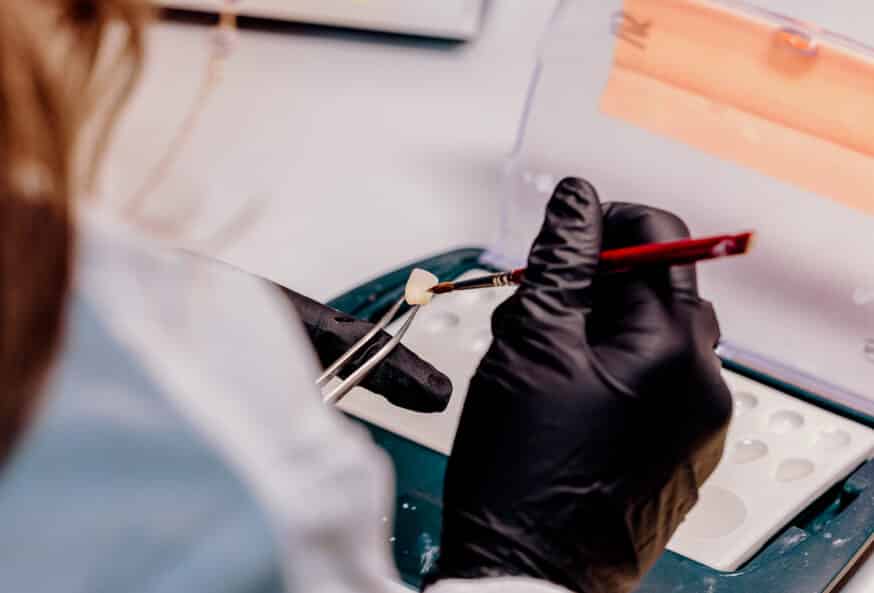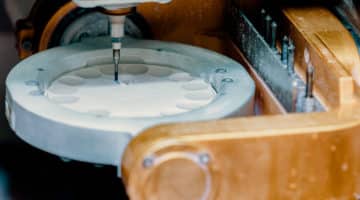Patients need crowns that look great, work well, and aren’t toxic to their body. Dentists want those things, too, and they want them made out of material strong enough to hold up to bite forces without fracturing. Zirconia crowns live up to these demands in many cases.
Zirconia was around for a long time before it became a material in dentistry. A German chemist Martin Heinrich Klapropse first introduced the idea of zirconium dioxide as a bioceramic in the 18th century. However, it didn’t start serving dentists as a restorative material until the late 20th century (1995).
Today, zirconia is a popular crown material in today’s dental operatories, often replacing materials like porcelain-fused-to-metal or even gold crowns. However, like any material, zirconia crowns have problems sometimes. In this article, we look at the advantages and disadvantages of zirconia crowns.
The three types of zirconia crowns
There are several types of zirconia materials. Each of them has different features and benefits that contribute to patient outcomes, which can affect what you want to choose for your case.
Zirconia has varying structures at different temperatures. It is monoclinic (i.e., the crystals have three axes of uneven length, and two of them are perpendicular to each other) at room temperature. However, mixing it with elements like yttrium, calcium, magnesium, or cerium, changes the structure as it stabilizes at room temperature.
For example, adding 8% yttrium (Y2O3) transforms the structure to cubic at room temperature, referred to as cubic-stabilized zirconia (CSZ). With 3-to-8% yttrium, it’s a mix of tetragonal and cubic phases at room temperature, called partially stabilized zirconia (PSZ). When it’s around 3% yttrium, it’s mostly tetragonal at room temperature and is called tetragonal zirconia polycrystal (TZP) or toughened zirconia. This TZP material was one of the early types of zirconia used in dentistry. Similarly, cerium-stabilized zirconia (Ce-TZP) also has a tetragonal structure when cerium is added.
To clarify the significance of the amount of yttrium in zirconia, it affects how strong and clear it is. It’s usually given as a percentage, like 3%, 4%, or 5%. However, it is critical to note that these percentages are actually in tenths, so a small change can make a big difference in the properties of the material.
For example, zirconia with about 3% yttrium is very strong, with mostly a tetragonal structure. On the other hand, zirconia with about 5% yttrium is more translucent, with about half of its structure being cubic. So, the amount of yttrium makes zirconia stronger or clearer.
The three types of zirconia used in dental crowns are:
The type of zirconia crown most appropriate for your patient depends on a range of factors, from the quality of the material itself to other patient-specific details. Let’s take a closer look at each type.
Solid or monolithic zirconia
Solid or monolithic zirconia, also called Full-Contour, is the most opaque of zirconia styles. Solid zirconia crowns are a popular choice because of their durability and because they require less occlusal clearance than other crown materials.
As a single material, monolithic zirconia has several advantages. First, it has flexural strength like its metal counterparts. It is also multichromatic. Since it is one single material, it has a manufactured consistency. Plus, it has great aesthetics with multi-layered color.
However, it also has a disadvantage. If you use it below the minimum thickness, it doesn’t perform.
Generally, monolithic zirconia is recommended for posterior crowns. There are two primary reasons for this:
- Monolithic zirconia is opaque. Monolithic zirconia lacks the translucency of other zirconia types, and the opaque color can be difficult to match teeth that are situated at visible points of the mouth.
- Monolithic zirconia contains many stabilizers. Oxide additives are used in zirconia to add strength and durability. Solid zirconia contains more of these stabilizers than other kinds of zirconia, making them perfect for the primary job of the molars at the back of the mouth—aka, chewing. Patients who tend to grind their teeth may also be better served by the durability of monolithic zirconia.
So, how long do zirconia crowns last? It depends on many things, but when you have a monolithic zirconia crown, chances are they will hold up for a long time. Also, in addition to their durability, monolithic zirconia crowns cause less wear to neighboring teeth.
Layered zirconia
The idea behind using multi-layered zirconia in dental work is to make artificial teeth look more like real ones. Natural teeth have a gradient in color, with the outer being more see-through and getting darker and less translucent towards the gumline. Various types of this layered zirconia are recommended for different dental procedures based on how they look and work.
Layered zirconia is coated with a special ceramic where the teeth are visible. However, only the visible surfaces are layered; the occlusal surfaces remain full zirconia to ensure durability.
With this modification, the answer to the question, “How long will this type of zirconia crown last?” will still be a satisfying answer.
The ceramic layering is why layered zirconia a popular choice for anterior crowns. There are a couple of reasons for this, which include:
- Layered zirconia creates a more realistic-looking smile. Compared to full zirconia, layered zirconia is more translucent and opalescent.
- Layered zirconia allows you to skip the extra layer if you want. The improved aesthetics mean you can use it in the visible zone with or without porcelain layering.
Another significant advantage of layered zirconia is that the color variation you see in the finished tooth is part of the zirconia itself. With older types of zirconia, the coloring was added to the outside of the restoration with special stains. However, if the patient brushed their teeth vigorously or had an acidic oral environment, those added colors could wear off, and the tooth would look the same color all over. With layered zirconia, even if the added color on the surface wears off, the tooth keeps its color variation because it’s built into the material.
Although layered zirconia is perfect for anterior crowns, it can also be used for posterior crowns, provided there’s room for the amount of clearance layered zirconia crowns require. However, when you are using it in the posterior, recognize that layered zirconia is weaker than monolithic zirconia, if only slightly.
High translucent zirconia
High translucent zirconia is considered the most natural-looking of all zirconia types. Its heightened translucency allows it to reflect the color of the teeth surrounding it, leading to crowns that blend in more with the rest of the teeth in the mouth.
The further individual benefits of high translucent zirconia may include:
- Enhanced durability – High translucent zirconia is sturdier than other kinds and far stronger than traditional porcelain crowns.
- A quicker implant procedure – High translucent zirconia doesn’t require any of the fine-tuning that other crowns need, like color shadings or glazes. This can also cut back on the time it takes for those kinds of additions to dry.
Explore Dandy Zirconia Crowns
Dandy offers a variety of different dental zirconia crowns with various strengths, durability, and aesthetics.

Zirconia crowns advantages
No matter what type of zirconia you and your patient decide on for their crowns, there are many ways this dental option can elevate their smile. Here are the three top advantages of zirconia crowns:
- Zirconia crowns are biocompatible. Biocompatibility means your patients don’t have to worry about their zirconia crowns negatively interacting with the living tissue in their mouth. Zirconia is non-toxic and naturally hypoallergenic.
- Zirconia crowns are customizable. Zirconia is an incredibly customizable material, thanks to its chemical composition and the range of technologies that have been developed to work with the material. When it comes to zirconia crowns, that means designing for the needs of specific patients is more feasible than ever. For your patients, this helps ensure a perfect fit and long-lasting comfort.
- Zirconia crowns are metal-free. Zirconia crowns contain zero metal, which makes them the obvious choice for people with nickel allergies or other metal sensitivities.
- Zirconia crowns are digital friendly. Due to new dental technology, zirconia crowns can be fabricated 100% digitally. You can start by taking a digital impression. The crowns are then digitally designed with CAD/CAM technology and are precisely milled so that seating requires fewer chairside adjustments.
- Zirconia crown cementation is easy. Zirconia crowns are cemented differently; however, the process can be simpler and more efficient than their other ceramic counterparts.
Zirconia crowns disadvantages
The disadvantages of zirconia crowns are essential to understand, also. For example, the opaque appearance of some zirconia types can make the restoration look less natural than other crown materials. Also, they can be pricier than crowns of other materials, which makes them less accessible for patients.
Furthermore, it is essential to remember that while zirconia crowns can be an excellent option for many patients, a few potential challenges associated with zirconia crowns could present. Let’s examine a couple of possible zirconia crown problems—and how innovative technology can help to mitigate them:
- Discoloration – In the past, it could be difficult and time-consuming to match zirconia crowns to the color of neighboring teeth. However, digital options like Dandy’s intraoral scanning technology nullify this problem with zirconia crowns; shade matching workflows help to ensure that digitally produced zirconia teeth are the perfect shade, creating a seamless aesthetic.
- Potential damage to neighboring teeth – Some members of the dental community have raised concerns that a hard, durable material like zirconia might wear away the comparatively soft texture of natural enamel in the neighboring teeth. To address this common issue, Dandy’s dedicated CAD design team places a special emphasis on proper spacing and alignment of zirconia teeth. Such digital workflows help to prevent any deterioration caused by wear and tear.
In addition, some contraindications for zirconia crowns can also occur. A zirconia crown is not recommended when the:
- Preparations have very little reduction (less than 0.6 mm) and thin walls.
- Strong biting forces occur where the opposing contact is zirconia also (as microscopic breakdown can occur)
- Opposing contact is made of cast gold or polymer (to prevent excessive wear)
- Case requires precision attachments
- Aesthetics are paramount (unless the dental lab can apply the right stains, fire it correctly, and polish it without making it look gray or shiny and without using a glaze)
Zirconia crowns with Dandy
The type of dental crown material that’s right for your patient will depend on a variety of factors, from aesthetics to individual needs and crown location. But when it comes to improving patient experience, increasing production, and optimizing your practice’s efficiency, there’s only one logical choice: going digital.
That’s where Dandy comes in. Our digital dental lab provides quality prosthetics based on custom scans that can only be achieved in an intraoral scanner. Get started with Dandy as your next crown and bridge lab. We start you off with a free intraoral scanner, then provide you with training and guidance every step of the way.
Ready to get started with digital dentistry? Get in touch!
Like what you’ve read?
We send emails on Tuesdays. Keep an eye out for the next one!
Sources:
Journal of Materials Research and Technology. Zirconia in dental prosthetics: A literature review: https://www.sciencedirect.com/science/article/pii/S2238785419300419
Materials. Optical and Mechanical Properties of Highly Translucent Dental Zirconia. https://www.ncbi.nlm.nih.gov/pmc/articles/PMC7435650/
Advanced Dental Arts NYC. Your Guide to Zirconia Dental Implants. https://advanceddentalartsnyc.com/everything-about-zirconia-implants/
AVF Dental Group. Zirconia Crown: Advantages and Disadvantages of Zirconia Crown. https://www.avfdentalgroup.com/blog/zirconia-crown-advantages-and-disadvantages-of-zirconia-crown/
Britannica, T. Editors of Encyclopaedia (2018, February 2). monoclinic system. Encyclopedia Britannica. https://www.britannica.com/science/monoclinic-system
Ban S. (2021). Classification and Properties of Dental Zirconia as Implant Fixtures and Superstructures. Materials (Basel, Switzerland), 14(17), 4879. https://doi.org/10.3390/ma14174879
Zirconia: The Material, Its Evolution, and Composition AEGIS Communications, B. J. O. B. (2018). Available at: https://www.aegisdentalnetwork.com/cced/special-issues/2018/10/zirconia-the-material-its-evolution-and-composition (Accessed: 26 October 2023).
Kolakarnprasert, N., Kaizer, M. R., Kim, D. K., & Zhang, Y. (2019). New multi-layered zirconias: Composition, microstructure and translucency. Dental materials : official publication of the Academy of Dental Materials, 35(5), 797–806. https://doi.org/10.1016/j.dental.2019.02.017
Arce, DDS, MD, FACP, Celin, et al. (2018). Multilayered Translucent Zirconia Crowns: Inside Dentistry. Retrieved from: https://www.aegisdentalnetwork.com/id/2018/04/multilayered-translucent-zirconia-crowns
Larson, J. (2020). Zirconia Crown Benefits, Disadvantages, Costs, Other Options. Retrieved from https://www.healthline.com/health/what-you-need-to-know-about-dental-crowns-made-from-zirconia
Zirconia Crowns: What Dentists and Labs Need to Know 2020! Retrieved from: https://www.cliniciansreport.org/products/single-topic-articles/single-topic-1-from-september-2020-volume-13-issue-9.php



